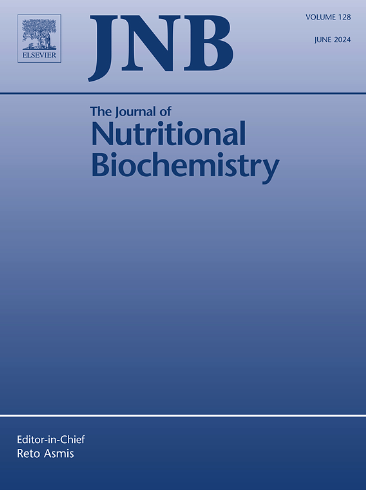饮食和生活方式决定因素维生素D状态在英国生物库队列研究预测模型
IF 4.9
2区 医学
Q1 BIOCHEMISTRY & MOLECULAR BIOLOGY
引用次数: 0
摘要
维生素D (VD)参与多种生理过程。人口中VD缺乏症的高患病率要求加强预防措施。目的是表征血液中VD水平和VD缺乏的饮食和生活方式决定因素,以进一步开发这两种结果的预测模型。共有63759名来自英国生物银行研究的参与者,通过24小时回忆评估饮食中VD的摄入量,并测量血清25(OH)D水平。应用线性和逻辑回归模型确定与VD水平和VD缺乏结局相关的因素,并评估协变量对血清VD和饮食VD之间相关性的影响。使用经典回归模型和基于惩罚似然方法的机器学习方法构建了两种VD结果的预测模型。大约10%的参与者有VD缺乏症(VD <;25 nmol/L), 38.9%存在VD不足风险(VD 25 - 49 nmol/L)。VD缺乏组饮食中VD的摄入量显著降低。后一组的体力活动(22.1%)低于非缺乏组(13.4%);术;措施)。此外,超重和肥胖(与正常体重相比)与VD缺乏的可能性更大相关(OR分别为1.18和1.96)。腹部肥胖患者VD缺乏的几率相似(OR=1.83)。根据参与者的报告,观察到膳食VD摄入量与VD水平之间的关联较弱。在阳光照射方面,较深的肤色(深色vs白皙=3.11)、季节(冬季vs秋季=3.76)和较少的户外活动(每1小时增加的OR =0.96)也与VD缺乏有关。经典回归和机器学习的预测模型都显示出良好的准确性(VD缺乏的AUC= 0.8-0.9)。总之,虽然富含VD的饮食会提高其水平,但阳光照射起着更重要的作用,尤其是在英国和北欧的人群中。包括关键决定因素的预测模型可以有效地评估VD缺乏症。本文章由计算机程序翻译,如有差异,请以英文原文为准。

Dietary and lifestyle determinants of vitamin D status in the UK Biobank Cohort study for predictive modeling
Vitamin D (VD) is involved in a wide variety of physiological processes. The high prevalence of VD deficiency in the population requires stronger preventive measures. The aim was to characterize the dietary and lifestyle determinants of VD levels in blood and of VD deficiency to further develop predictive models of these two outcomes. A total of 63,759 participants from the UK Biobank study with available data on dietary intake of VD, assessed via 24-hour recalls, and with measurements of serum 25(OH)D levels were included. Linear and logistic regression models were applied to identify factors associated with VD levels and VD deficiency outcomes, and to evaluate the influence of covariates on the association between VD in serum and VD in the diet. Predictive models for both VD outcomes were constructed using classical regression models and machine learning methods based on penalized likelihood methods. Approximately 10% of the participants had VD deficiency (VD < 25 nmol/L), and 38.9% were at risk of VD inadequacy (VD 25–49 nmol/L). The dietary intake of VD was significantly lower in the VD deficient group. This latter group showed lower engagement in physical activity (22.1%) compared to the non-deficient group (13.4%; P<.001). Also, overweight and obesity (vs normal weight) were related to a greater likelihood of VD deficiency (OR=1.18 and 1.96, respectively). A similar odds of VD deficiency was observed for abdominal obesity (OR=1.83). A weaker association was observed between dietary VD intake, based on participant reports, and VD levels. With regard to sunlight exposure, darker skin tones (OR dark vs fair skin=3.11), season (OR winter vs autumn=3.76) and less outdoor time activities (OR per 1 h increase=0.96) were also related to VD deficiency. Predictive models for both classical regression and machine learning, showed good accuracy (AUC=0.8–0.9 for VD deficiency). In conclusion, while a rich diet in VD boosts its levels, sun exposure plays a more significant role particularly in populations from the UK or Northern Europe. A predictive model including key determinants could effectively assess VD deficiency.
求助全文
通过发布文献求助,成功后即可免费获取论文全文。
去求助
来源期刊

Journal of Nutritional Biochemistry
医学-生化与分子生物学
CiteScore
9.50
自引率
3.60%
发文量
237
审稿时长
68 days
期刊介绍:
Devoted to advancements in nutritional sciences, The Journal of Nutritional Biochemistry presents experimental nutrition research as it relates to: biochemistry, molecular biology, toxicology, or physiology.
Rigorous reviews by an international editorial board of distinguished scientists ensure publication of the most current and key research being conducted in nutrition at the cellular, animal and human level. In addition to its monthly features of critical reviews and research articles, The Journal of Nutritional Biochemistry also periodically publishes emerging issues, experimental methods, and other types of articles.
 求助内容:
求助内容: 应助结果提醒方式:
应助结果提醒方式:


